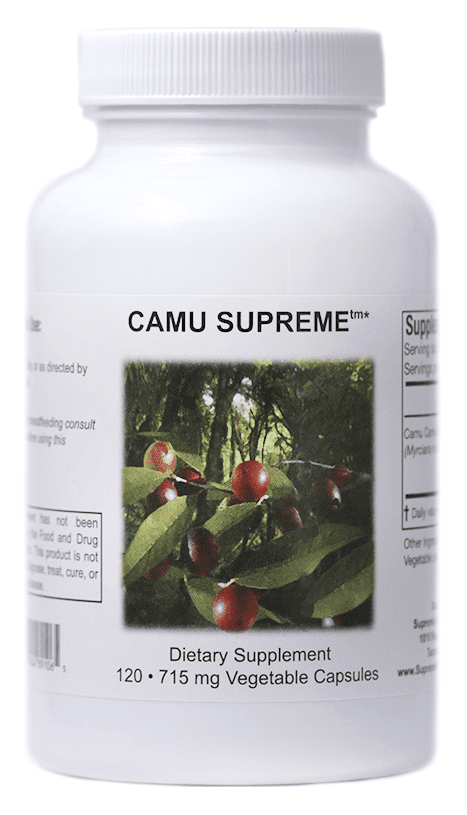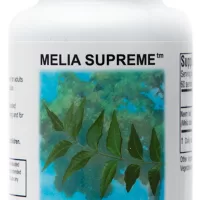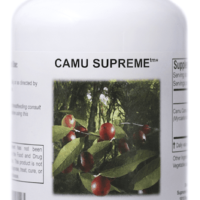Description
Camu Supreme
Camu Supreme is a single food that we have known about for a long time but like many of our other products it took a while to find a source that passed our testing methods and that wasn’t diluted with maltodextrin as most are. Camu is a berry from a bush (Myrciaria dubia) that grows in the Amazon rainforest. What makes camu stand out is that it is the 2nd most concentrated source of vitamin C found in any fruit. It is also a significant source of antioxidants including anthocyanins, d-limonene, and catechin [1, 2, 3]. Dr James Duke in his ethnobotanical database rates camu as being an effective antiviral, very useful for gingivitis and other periodontal disease, asthma, hepatitis, atherosclerosis, infertility, cataracts, migraine and cluster headaches, colds, osteoarthritis, depression, edema and Parkinson’s disease [4]. According to Sloan Kettering of the Memorial Sloan Kettering Cancer Center, Camu Supreme decreases inflammatory and oxidative stress markers such as 8-hydroxy-deoxyguaosine, total reactive oxygen species, C reactive protein, IL-6, and IL-8 in smokers [5].
In one study after taking Camu for 7 days, patients had a significant decrease in total oxygen reactive species, decrease in high sensitivity C Reactive protein (hs-CRP), and decrease in IL-6 and IL-8. A control group taking an equivalent amount of vitamin C showed no change in these same markers [6]. In another study obese rats were fed Camu for 12 weeks and those that received the pulp of camu reduced their weights of the fat in white adipose tissues, glucose, total cholesterol, triglycerides, LDL-c and insulin blood levels. There was also an increase in HDL-c levels [7].
In addition to being high in Vitamin C, camu is also high in phenolic compounds and carotenoids. Camu Supreme is a good source of potassium, iron, calcium, phosphorous and various amino acids including serine, valine and leucine. Due to these properties Camu could possibly be used to help stop the progression or prevent certain diseases such as cardiovascular and cancer [8]. Camu also has been shown to suppress the formation of edema in rats and contains betulinic acid. Betulinic acid has antiretroviral, antimalarial, anti-inflammatory, and anticancer properties [9].
We will not be stating vitamin C content on the label as it can vary depending on many variables (time harvested, soil and climate conditions) but an average dose of 1 scoop will have anywhere in the range of 200mg-1000mg in synergy with all the accompanying components (various research articles give differing amounts due to the factors just mentioned, thus the wide range) [10]. It is hard to compare natural vitamin C in the complex of a whole food to isolated ascorbic acid but it appears you need much less when taking it as a whole food source and the exact milligrams is not as relevant as how it works as a complete food [11].
Many of our physician customers have reported it to be effective in helping alleviate symptoms of hay fever and allergic rhinitis in doses of 3-4 scoops daily.
Dosage:
A good maintenance dose is one scoop daily but for acute and chronic conditions that need higher amounts of vitamin C, bioflavinoids and antioxidants you can do 2-3 scoops daily or more. People starting to come down with a cold often report getting helped by taking 1 scoop 4x throughout the day.
For a daily dose make a smoothie that contains some juice, frozen berries, 1 scoop of Thera Supreme, 1 scoop of Wild Greens Supreme, and 1 scoop of Camu Supreme. Camu has a pleasant, yet sour taste. If you want something simple you can just mix a scoop into juice, coconut milk or some other milk, yogurt or water alone.
Camu falls into the class of superfoods and makes a great addition to your diet.
Resources:
1. Zanatta, Cinthia Fernanda, Elyana Cuevas, Florinda O. Bobbio, Peter Winterhalter, and Adriana Z. Mercadante. “Determination of Anthocyanins from Camu-camu ( Myrciaria Dubia ) by HPLC−PDA, HPLC−MS, and NMR.” Journal of Agricultural and Food Chemistry J. Agric. Food Chem. 53.24 (2005): 9531-535. Web.
2. Franco, Maria Regina B., and Takayushi Shibamoto. “Volatile Composition of Some Brazilian Fruits: Umbu-caja ( Spondias Citherea ), Camu-camu ( Myrciaria Dubia ), Araça-boi ( Eugenia Stipitata ), and Cupuaçu ( Theobroma Grandiflorum ).” Journal of Agricultural and Food Chemistry J. Agric. Food Chem. 48.4 (2000): 1263-265. Web.
3. Chirinos, Rosana, Jorge Galarza, Indira Betalleluz-Pallardel, Romina Pedreschi, and David Campos. “Antioxidant Compounds and Antioxidant Capacity of Peruvian Camu Camu (Myrciaria Dubia (H.B.K.) McVaugh) Fruit at Different Maturity Stages.” Food Chemistry120.4 (2010): 1019-024. Web.
4. Duke, James. “Dr. James Duke on Camu Camu.” Web. 5 June 2015.
5. Ketterin, Sloan. “Camu-camu.” Camu-camu. Memorial Sloan Kettering Cancer Center, n.d. Web. 05 June 2015.
6. Inoue, Teruo, Hiroshi Komoda, Toshihiko Uchida, and Koichi Node. “Tropical Fruit Camu-camu (Myrciaria Dubia) Has Anti-oxidative and Anti-inflammatory Properties.” Journal of Cardiology 52.2 (2008): 127-32. Web.
7. Nascimento, Ozanildo V., Ana P.a Boleti, Lucia K.o Yuyama, and Emerson S. Lima. “Effects of Diet Supplementation with Camu-camu (Myrciaria Dubia HBK McVaugh) Fruit in a Rat Model of Diet-induced Obesity.”Anais Da Academia Brasileira De Ciências An. Acad. Bras. Ciênc. 85.1 (2013): 355-63. Web.
8. Akter, Mst. Sorifa, Sejong Oh, Jong-Bang Eun, and Maruf Ahmed. “Nutritional Compositions and Health Promoting Phytochemicals of Camu-camu (myrciaria Dubia) Fruit: A Review.” Food Research International 44.7 (2011): 1728-732. Web.
9. Yazawa, Kazunaga, Katsumi Suga, Atsushi Honma, Miyuki Shirosaki, and Tomoyuki Koyama. “Anti-Inflammatory Effects of Seeds of the Tropical Fruit Camu-Camu (Myrciaria Dubia).” J Nutr Sci Vitaminol JNSV Journal of Nutritional Science and Vitaminology 57.1 (2011): 104-07. Web.
10. Rodrigues, Roberta B., Hilary C. De Menezes, Lourdes M.c. Cabral, Manuel Dornier, and Max Reynes. “An Amazonian Fruit with a High Potential as a Natural Source of Vitamin C: The Camu-camu ( Myrciaria Dubia ).”Fruits 56.5 (2001): 345-54. Web.
11. Vinson, JA. “Comparative Bioavailability to Humans of Ascorbic Acid Alone or in a Citrus Extract.” National Center for Biotechnology Information. U.S. National Library of Medicine, Sept. 1988. Web. 05 June 2015.






